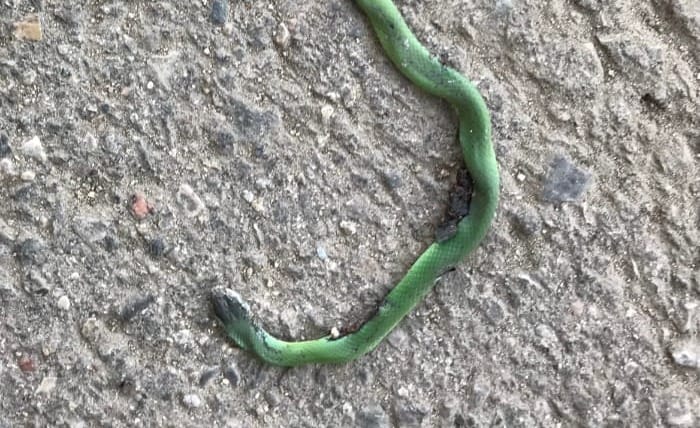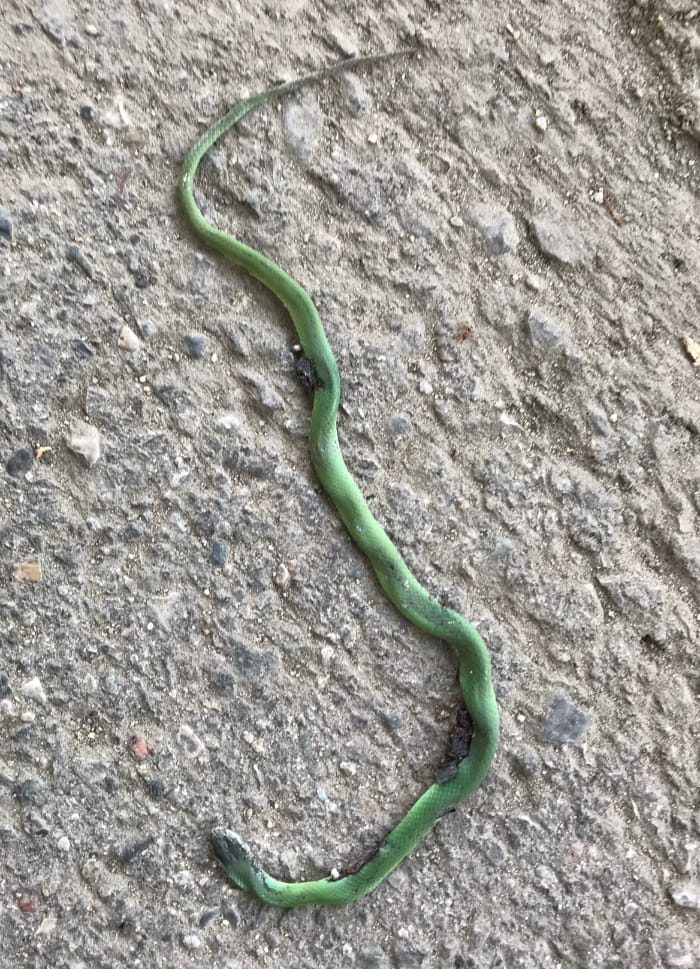
Valley views – Smooth green snake
Rare and well-camouflaged, the smooth green snake is a hidden resident of the Qu’Appelle Valley and across southern Canada.
- By Barry A. Mitschke
September, 2025
key points from this story:
- Rarely seen in the Qu’Appelle Valley
- Found dead on trails and highways
- Prefers grassy habitats and flat stones
- Officially listed as vulnerable in Manitoba
- Eats insects and small creatures whole
- Eggs incubate under sun-warmed stones
They are rarely seen. In the 40 years or so that I have lived in the Qu’Appelle Valley, I think I have seen one slither across a trail while hiking. I have seen dead ones along Highway #20, and on various trails. The enclosed picture shows one that I found while hiking in early August along the Tran-Canada trail at Katepwa Lake. It was probably run over by a golf cart or quad. Serendipity strikes again. I was planning to write a column about the Smooth Green Snake (SGS, or Opheodrys vernalis), when “low and behold”, an article was published in the recent Fall issue of the Blue Jay, the official magazine of Nature Saskatchewan, pages 6-8.

(Duncan, James R. “Smooth Green Snake use of dried cow “patties” (feces) as cover in prairie in southern Manitoba”; has two B&W pictures of the snake.) Listed as “Vulnerable” in Manitoba, the snake can be found across southern Canada, the Eastern and Middle States, and down to Florida, Texas and New Mexico. Because of their smooth, shiny pale-to-brighter-green colour, they are perfectly camouflaged by any grassy habitat, such as Valley sides, fields or marshes. They are able to “climb” bushes, but they like to live under flat stones. (Scientists in Manitoba were deliberately using wood/plywood boards or tin plates to find and study them. The author found his very first ones under cow “patties”; bison poop would suffice, too.)
These snakes may be 30-50 cm or longer (12-20 inches plus), and are “pencil” thin. Harmless and inoffensive, SGSs are also non-poisonous! Swallowing whole, their food is usually insects (grasshoppers, crickets, smooth caterpillars), spiders, and perhaps snails or small salamanders. Laying capsule-shaped eggs strung together in 2-8 groups, incubation happens under stones warmed by the sun. Hatching takes 4-21 days, and the snakelings are stout, dark-olive and unusually active (see Palmer & Fowler’s (1975) Fieldbook of Natural History, page 542 ). Unlike birds and wildflowers which are easily evident and observed, one has to be in the right place at the right time with a camera to get evidence of these beautiful little snakes. Keep your eyes open as you get out there to enjoy Nature in the Valley or elsewhere.
Inquiring
…. Am I afraid of snakes? …. even small, non-poisonous ones like SGSs? If so, why? Which Trans-Canada Trail (TCC) segments have I hiked? … in SK? … in Canada? What unique wildlife did I find? What else lives under cow or bison “patties”?
Last Mountain Times Newsletter
Join the newsletter to receive the latest updates in your inbox.



